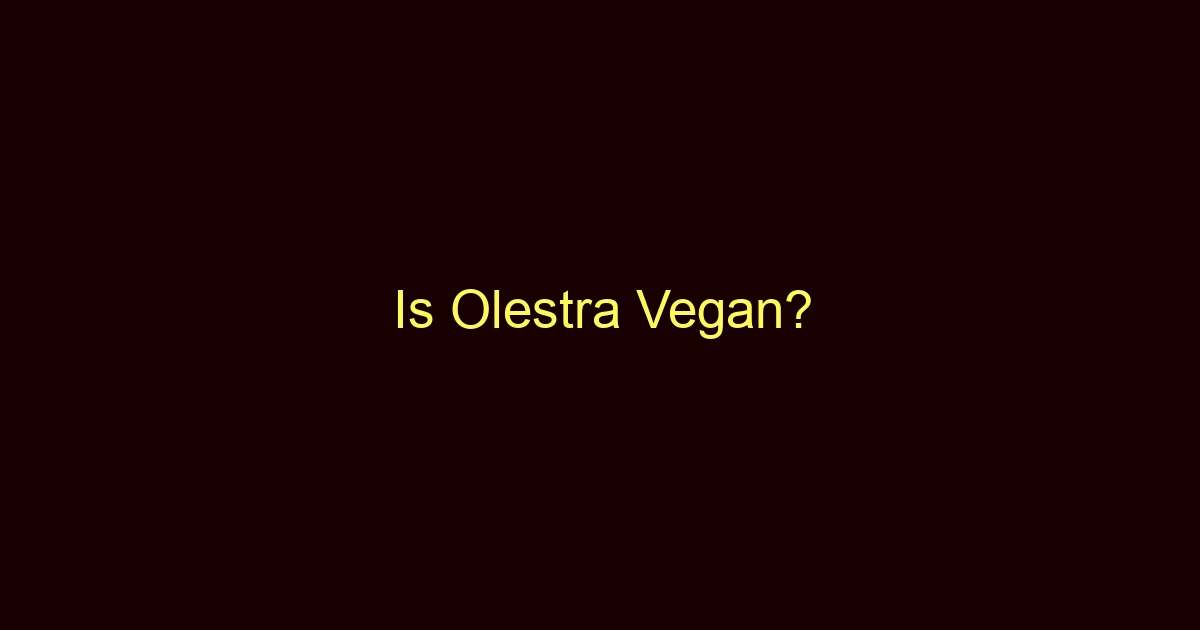Olestra, an intriguing product of food science, has been the subject of ongoing debate in the nutrition world. Its unique properties have earned it a place in many fat-free products, but is it fit for everyone’s dietary needs? Specifically, is Olestra vegan? Let’s dive into the world of this fat substitute and explore it from a vegan perspective.
What is Olestra?
Olestra, trade-named Olean, is a fat substitute that adds no calories or fat to foods. It was developed by Procter & Gamble in the 1960s, gaining FDA approval in 1996 for use in snacks like chips and crackers. The unique thing about Olestra is its structure, which is made of sugar and vegetable oil but is too large and dense to be broken down and absorbed by the body.
This means it can provide the taste and texture of fat without the calories. However, due to this structure, it can lead to some gastrointestinal issues, since the body can’t process it. So, what exactly is Olestra made of?
What is Olestra Made of?
Olestra is synthesized by combining sugar molecules (usually sucrose) with fatty acids derived from vegetable oils such as soybean, cottonseed, or canola oils. This forms large, lipophilic (fat-soluble) molecules. Due to their size and structure, these molecules are not hydrolyzed by digestive enzymes in the human body, so they don’t provide any calories or nutritional value.
Olestra’s production involves no animal-derived ingredients or products, which is a point in favor of its vegan suitability. However, it’s essential to look further into what Olestra is used for and where you might encounter it.
What is Olestra Used For?
Olestra is used as a zero-calorie, zero-fat substitute in various food products. Its primary use is in snacks, like potato chips and crackers, that aim to deliver the same taste and texture as their full-fat counterparts but without the high calorie and fat content.
What Foods Contain Olestra?
Olestra can be found in a variety of fat-free and low-fat snacks. It’s been used in brands like Lay’s Light chips, Pringles Light chips, and other similar products. However, it’s essential to read labels carefully, as not all fat-free or low-fat snacks contain Olestra.
Is Olestra Vegan?
Yes, Olestra is vegan. It’s synthesized from plant-derived ingredients – specifically, vegetable oils and sugars. No animal-derived ingredients or products are involved in its production. However, just like with fructose, it’s crucial to remember that a food’s vegan status doesn’t automatically make it healthful or suitable for everyone’s diet.
Although Olestra may offer lower calorie and fat content, it can lead to potential digestive issues and prevent the absorption of some fat-soluble vitamins. As a result, even though vegans can technically consume Olestra, they should do so mindfully and in moderation.
Can Vegans Eat Olestra and Why?
Yes, vegans can eat Olestra. The reason is its plant-derived composition, free from animal products. However, despite being vegan, it’s crucial for vegans – and, indeed, all consumers – to consider potential health implications.
Olestra doesn’t get digested or absorbed, so while it provides a fat-like texture and flavor without the calories, it can cause gastrointestinal issues. Furthermore, it can reduce the absorption of some fat-soluble vitamins (A, D, E, and K), and carotenoids, nutrients found in colorful fruits and vegetables. Therefore, although vegans can consume Olestra, it should be done responsibly and in moderation.
Health Concerns With Olestra
While Olestra may seem like a dream come true for those looking to cut fat and calories from their diet, it does come with its concerns. Because of its indigestible nature, it can cause digestive problems such as cramping, bloating, and diarrhea.
Moreover, Olestra can interfere with the absorption of some vital nutrients, such as vitamins A, D, E, K, and carotenoids. Some companies add these vitamins back into their Olestra-containing products, but the concern for nutrient malabsorption remains.
Role of Olestra in a Balanced Diet
Olestra can have a place in a balanced diet, especially for those looking to reduce their calorie and fat intake. However, it’s critical to consume it mindfully due to its potential side effects. Foods with Olestra should not replace nutrient-dense foods, which provide essential vitamins, minerals, and other nutrients.
Remember, the aim should always be to maintain a balanced and varied diet. That means consuming plenty of fruits, vegetables, whole grains, legumes, and healthy fats, even if you choose to include some Olestra-containing foods.
Is Olestra Safe?
Olestra is considered safe for human consumption by the FDA. However, it does come with potential side effects, especially when consumed in large quantities. Its consumption might lead to gastrointestinal discomfort and could interfere with the absorption of certain vitamins and carotenoids.
Individuals with a sensitive digestive system or who are prone to nutrient deficiencies may want to limit their Olestra consumption. As always, if you experience any adverse reactions, consult with a healthcare professional.
Final Thoughts
Olestra is indeed vegan. Its production involves no animal products or byproducts, relying instead on vegetable oils and sugars. However, while it can help reduce calorie and fat content in foods, it’s crucial to consume it wisely due to potential digestive issues and nutrient malabsorption.
Vegans can consume Olestra, but it’s essential to remember that a food being vegan doesn’t automatically make it beneficial for health. Consuming a balanced, varied diet with plenty of whole, nutrient-dense foods is the key to maintaining good health.

